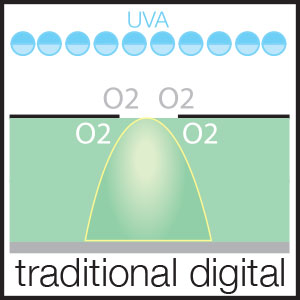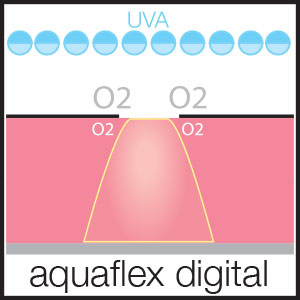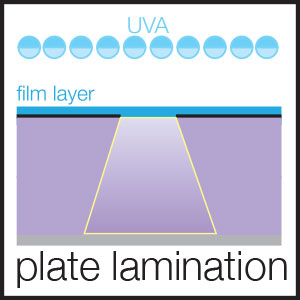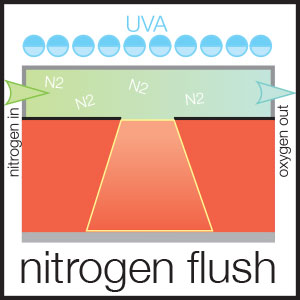Introduction:
The importance of dot formation and plate quality has not gone unnoticed over the years. In fact, these traits have been the basis for many innovations, both recent and historic. In the 1970s, photopolymer was introduced as an improvement in quality over molded rubber due to its ability to transfer an image directly from a photographic negative to the photopolymer plate. In the 1990's, digitally imaged plate technology allowed the image to be transferred directly to the plate surface, eliminating the need for film and further improving accuracy. With this transition, a phenomenon called oxygen inhibition was discovered (more detail about O2 inhibition to come). It was with this transition that the importance of dot structure began to take shape.
Where do digitally imaged flat top dots come in? We know through industry testing that there are certain applications where flat top dots are the better choice, and others where sharpened dots provide the best result. Generally speaking, flat top dot technologies do not provide great highlight quality, but can offer benefits for solid ink density and ink laydown when paired with solid screening technologies. On the other hand, sharpened dots can provide excellent highlight quality, but the traditional digital platemaking method used to create this dot structure does not provide any additional benefit in the solid areas. The ultimate goal of most flexographic printers is to find the balance between these extremes and produce fine, clean highlight detail while also printing even, dense solids.
Why do rounded dots excel in highlight areas when compared to flat top dots?Although round dots are more apt to gain when greatly over-impressed, they have the ability to print a much smaller, finer dot when proper impression is set. This is due to the rounded contact point of the dot.
Finding Balance with Aquaflex Optima
There are many strategies flexographic printers use to find this ideal balance between solids and highlights. Perhaps the most common strategy is to deploy a hybrid screening technology. That is, a screening pattern that in the highlight areas, removes dots from the grid to decrease tonal value down to zero, while maintaining minimum dot size throughout the scale. These screening patterns can be quite effective with most plate technologies, and are usually necessary with flat top dots due to the substantial highlight dot gain. The drawback to employing hybrid screening is the grainy appearance that can be seen in the extreme highlight areas. Even at high line screens exceeding 150 LPI, it can be difficult to overcome the grainy appearance due to the small number of dots in the highlight dot pattern, although most viewers prefer graininess over a hard-edged drop to zero. The Aquaflex Optima family of plates has displayed outstanding printing characteristics in this regard. The unique dot formation characteristic of the Aquaflex photopolymer offers excellent highlight dot detail while maintaining optimum ink transfer, all without hybrid screening or specialized exposure technologies.
The Oxygen Sharpening Effect: How Optima is Different
You may have heard the term oxygen inhibition (or dot sharpening) before, in conjunction with digital plates. This effect causes the tips of digital dots to be rounded. Here is an explanation of this phenomenon:
Exposure in the presence of oxygen (most digital plate materials):
- Oxygen atoms bond with the polymer chains on the surface of the plate during the polymerization reaction, causing incomplete polymerization of the surface layer. This results in rounded dots on most plates.

Exposure without oxygen:
Oxygen is sealed or flushed out, eliminating it from the exposure environment. This results in a flat top dot. Oxygen-free exposures can happen in two ways:
Exposure in the presence of oxygen (Aquaflex Optima):
- Due to Aquaflex's unique photopolymer construction, oxygen atoms cannot bond as easily to the photopolymer during the polymerization reaction, causing the plate to have a very low bump curve and flatter dot profile than traditional rounded digital dots. The result is a stable, unique dot profile that prints with stability in extreme highlights while maintaining low dot gain.

This unique "virtually flat" dot profile allows the Aquaflex plate to provide fine highlight detail while maintaining stability and cleanliness throughout the entire press run. On the following pages, you will find data from press runs of the Aquaflex Optima family of plates. All plates in these trials were made with no bump curve, so the true minimum printing dot is visible and measurable.
- Highlight Results
- Aquaflex Optima DOPH 1.70
- Highlight data from narrow web press runs in 2013.
- Measured with Techkon SpectroDens spectrodensitometer.
- Min dot is measurement of the final printed dot.
The density results below show that the Aquaflex plate delivers above-average ink transfer, even with softer tapes. This results in consistent, dense solids without the need for added surface screening.
- Solid Ink Results
- Aquaflex Optima DOPH 1.70
- Solid ink density data from narrow web press runs in 2013.
- Measured with Techkon SpectroDens spectrodensitometer using Status T.
Additional Benefits of the Aquaflex Plate Family
The Aquaflex family of plates shares other unique characteristics other than dot formation that can benefit the end user greatly. The entire platemaking process from start to finish is less than 35 minutes, excluding the laser imaging time. Also, the plate is processed in 96% water, 4% surfactant solution that does not absorb into the photopolymer, which results in absolutely no swelling, very short drying time, excellent dimensional stability, and accurate registration from plate to plate. All of these benefits come in an entirely VOC-free platemaking process.
Here is what the platemaking process looks like:
We are currently seeking print trials in a variety of narrow, mid, and wide web printing conditions. If you are interested in more information, or participating in a trial with this exciting plate technology, please contact your local All Printing Resources technical sales representative, or Catherine Green (c.green@teamflexo.com) of the technical solutions group.
Click here to learn more about Aquaflex Plates.







